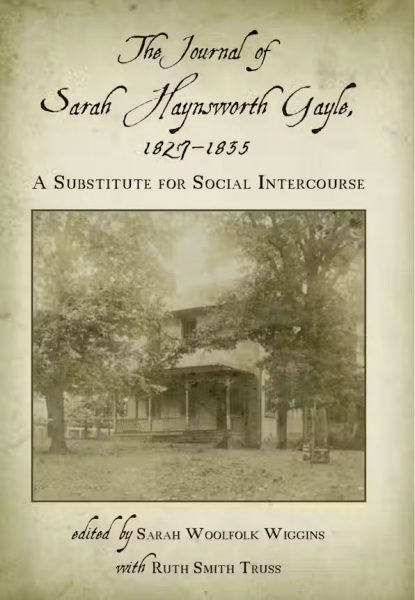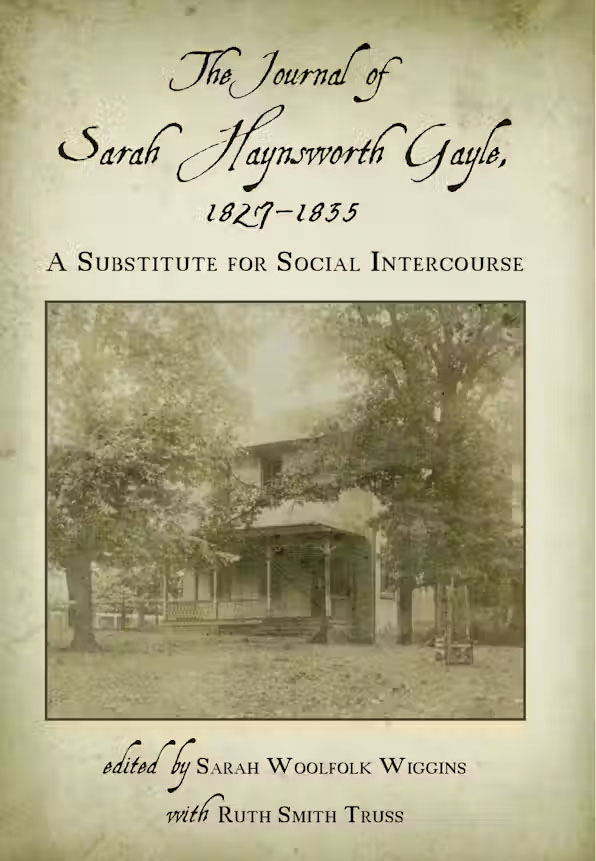Sarah Ann Haynsworth Gayle
Sarah Ann Haynsworth Gayle (1804-1835) was the first wife of Gov. John Gayle (1831-1835) and the mother of Amelia Gayle Gorgas, wife of Confederate general Josiah Gorgas. Sarah maintained a journal from 1827 to 1835 that became her social and intellectual companion in the decades immediately after Alabama attained statehood in 1819. Her journal is unique as the only surviving account of early Alabama life written by a woman.
Born near Sumter, South Carolina, on January 18, 1804, Sarah Ann Haynsworth was the only child of Sarah Ann Pringle and Richard Haynsworth. In 1810, the family moved as part of the migration of farmers from the exhausted fields of the seaboard Piedmont to the fertile Black Belt region of the Mississippi Territory, which at the time encompassed present-day Alabama. The Haynsworths settled near present-day Mount Vernon, Mobile County, in a region largely under the control of the Choctaws. The area was virtually a frontier with few educational opportunities for children, and Sarah received only elementary instruction at St. Stephens Academy. After the Creek War of 1813-14, the Haynsworths moved east to another sparsely populated area near Claiborne in Monroe County and acquired land to farm. Sarah named their home Sheldon Plantation.
On November 14, 1819, Sarah married John Gayle, another South Carolinian who had moved west. Sarah was not yet 16, and John was 27. Her husband's career as an ambitious young attorney had led him into territorial politics, and he would move upward quickly in state government. Sarah quickly found herself the mother of baby after baby almost every other year. She had eight children, two of whom were stillborn. Her life revolved around caring for her children while her husband was absent for extended periods.
Around 1825, the Gayles moved from Claiborne to Greensboro and built a simple two-story frame house there in l828. Sarah's parents were now dead, and no family of her own remained in Alabama. Desperately lonely but foregoing self-pity, Sarah dealt with her emotional needs in the manner of most women of her time and economic class. First, she built a web of women friends and in-laws who became her support network during John's frequent absences. Next, Sarah began keeping a journal, engaging with it as if it were a living confidant. Her journal presents a portrait of a self-analyst; she viewed herself objectively as she sought to know herself. It became her catharsis intended for her eyes only; but it was also a detailed commentary on the daily world of early nineteenth-century Alabama. She noted the patterns of courtship and marriage, the position of women and their legal rights, relationships among enslaved people and the planters and others who owned them, and the violent world around her. Sarah described her opinions and thoughts, observed her neighbors' good and bad behavior, and worried about the effects of her husband's absences on their children.
Possessed of an enormous intellectual curiosity, Sarah attempted to engage with local ministers, the best educated contemporaries in her community. But she quickly found that educated men would not discuss serious subjects with women. Therefore, she bolstered her limited formal education with voracious reading. She read the works expected of southerners—those of Sir Walter Scott and Washington Irving—but she also read theology and religious sermons, Restoration comedy, political speeches, educational treatises, poetry, drama, travel accounts, ancient and contemporary history, and biography. She became familiar with French writers Voltaire and Richelieu and British authors James Boswell and Samuel Johnson, as well as with such less well-known persons as Frances Wright, a Scottish abolitionist who dared to advocate birth control and universal suffrage for women and blacks in the 1820s South. Although the Gayles owned slaves, Sarah read the works of William Wilberforce, the premier British abolitionist.
Lonely and depressed, Sarah Gayle sought comfort in opium, then viewed as no more dangerous or scandalous than the use of alcohol or snuff. As a result, she suffered poor health—rotting teeth, failing eyesight, and mental health problems. It is impossible to determine exactly when she began to use opium. The only surviving proof of her addiction is a postscript in a letter to her husband dated May 3, l832. She may have mentioned using the drug in her journal, but text in the journal has been scratched out, and many pages have been removed.
John Gayle provided a steady income for his family from his judicial and political offices and his successful legal practice. Still, the Gayles were constantly pressed financially as John regularly covered the debts of his brother, Levin, who held no regular employment for the nine years that Sarah maintained her journal. Sarah had inherited slaves from her father, and despite her objections John sold some of them to satisfy Levin's creditors. That her husband could sell her property inherited from her father deeply disturbed Sarah and explains her interest when the legislature considered the "Ladies' Bill," which would have given women the right to own inherited property had it passed. The legal rights of women were one of the few legislative issues that she discussed in her journal. After John was elected governor in 1831, Sarah and the children remained in Greensboro, while he took rooms in Tuscaloosa.
In late 1833, Pres. Andrew Jackson sent Francis Scott Key to Alabama to resolve a festering quarrel that threatened to explode into violence as white squatters settled on land already granted to the Creek Indians. While visiting the Gayle family, Key wrote some verses in the album of Sarah's nine-year-old daughter, Sarah Ann. Immediately, the child's friends clamored for the visitor to write in their albums also. Sarah Gayle then requested in verse that Key write in the album of one of the children (a relative of a prominent Alabama politician), and he did as Sarah Gayle asked. The poem written to nine-year-old Sarah Ann Gayle has often been incorrectly described as a poem by Key to the adult Sarah Haynsworth Gayle.
John Gayle was elected to a second term as governor in 1833, and the entire Gayle family moved to Tuscaloosa in 1834 after the legislature required the governor to live in the state capital. Levin Gayle moved his family into his brother's vacant house in Greensboro and remained there until John sold it in l835. Because the state did not provide a residence for the governor and his family, the Gayles lived in local taverns for more than a year. With five children, tavern life was very uncomfortable, and the family moved into a house after Sarah gave birth to her sixth child.
In Tuscaloosa, the Gayles became close friends with Alva Woods, president of the University of Alabama, and his wife, Almira. Their friendship gave the Gayles the opportunity to observe closely the unruly behavior of university students as Pres. Woods struggled to transform them into gentlemen scholars. These young men, accustomed to the freedom of life in the Old Southwest, found the discipline and the restrictions of university life to be intolerable. In her journal, Sarah described with disapproval the violence that frequently erupted among the students, as well as their physical assaults with weapons on faculty members, the university president, and Tuscaloosa residents.
In July 1835, Sarah arranged to have some dental work done while John was away on business with the Chickasaw Nation. Within days after the dental surgery, she developed lockjaw, and John Gayle was informed that Sarah was dying. Although he hurried home, she died on July 31 before he arrived. After a funeral at the Methodist church in Tuscaloosa, she was buried at the Haynsworth home, Sheldon Plantation, according to her wishes. Sometime later, her body was moved to the Gayle family plot in Magnolia Cemetery in Mobile. She left six children ranging in age from 14 years to five months.
Further Reading
- Gorgas Family Papers, Hoole Special Collections, University of Alabama, Tuscaloosa, Alabama.
- Wiggins, Sarah Woolfolk, ed. The Journal of Sarah Haynsworth Gayle, 1827-1835: "A Substitute for Social Intercourse." Tuscaloosa: University of Alabama Press, 2014.
- Wiggins, Sarah Woolfolk. "Sarah Gayle and Violence in the Old Southwest." Alabama Heritage (Winter 2015): 27.






